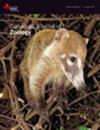与系统发育预测相反,耳鸽的冠色不受性激素调节
IF 1
4区 生物学
Q3 ZOOLOGY
引用次数: 0
摘要
鸟类物种的羽色调节机制似乎在系统发育上是保守的:多形性特征状态是雌激素依赖性调节,而睾酮、黄体生成素和非激素控制则是衍生状态。有关耳鸽(Zenaida auriculata des Murs,1847 年)性双色性的基本调节过程的数据有限。由于哥伦布形目接近基干分支,我们假设雌激素和睾酮在耳鸽冠羽着色的调控过程中起着核心作用。为了验证这一假设,我们对成年雄鸟进行了强制蜕皮,同时外源性增加雌二醇和睾酮,以确定蜕皮期间这些激素的存在是否会改变羽色的分光光度特性。在色调、紫外线饱和度和亮度等色度变量方面,处理组和对照组之间没有发现明显差异。同样,鸟类视觉模型显示,雄性成鸟个体的色度和消色差信号没有明显变化。我们还分析了雌激素和睾酮对新羽毛生长速度的影响。与对照组相比,激素处理组的蜕皮速度有所提高。这些结果表明,耳廓鸽是基枝模型的一个例外:性激素不是调节颜色,而是加速新羽毛的生长。本文章由计算机程序翻译,如有差异,请以英文原文为准。
Contrary to phylogenetic predictions, crown coloration of the Eared Dove is not regulated by sex hormones
The mechanisms regulating plumage coloration appear to be phylogenetically conserved in avian species: the plesiomorphic character state is estrogen-dependent regulation while testosterone, luteinizing hormone and non-hormonal control are derived states. Limited data exist on the underlying regulatory processes of sexual dichromatism in the Eared Dove (Zenaida auriculata des Murs, 1847). Since the Columbiformes order is close to basal branches, we hypothesised that estrogen and testosterone play a central role in the regulation of crown plumage coloration in the Eared Dove. To test this, we subjected adult males to a forced molt accompanied by an exogenous increase of estradiol and testosterone to determine whether the presence of these hormones during molting modified the spectrophotometric characteristics of the plumage. No significant differences were found between treatments and controls in the colorimetric variables hue, ultraviolet saturation and brightness. Similarly, the avian visual model showed no perceptible changes in chromatic and achromatic signals in the individual male adults. We also analysed the effects of estrogen and testosterone on the growth speed of the new feathers. The hormone-treated groups increased in the speed of molting compared to the control group. These results suggest that the Eared Dove is an exception to basal branch models: rather than regulating coloration, sex hormones speed up the growth of the new feathers.
求助全文
通过发布文献求助,成功后即可免费获取论文全文。
去求助
来源期刊

Canadian Journal of Zoology
生物-动物学
CiteScore
2.40
自引率
0.00%
发文量
82
审稿时长
3 months
期刊介绍:
Published since 1929, the Canadian Journal of Zoology is a monthly journal that reports on primary research contributed by respected international scientists in the broad field of zoology, including behaviour, biochemistry and physiology, developmental biology, ecology, genetics, morphology and ultrastructure, parasitology and pathology, and systematics and evolution. It also invites experts to submit review articles on topics of current interest.
 求助内容:
求助内容: 应助结果提醒方式:
应助结果提醒方式:


